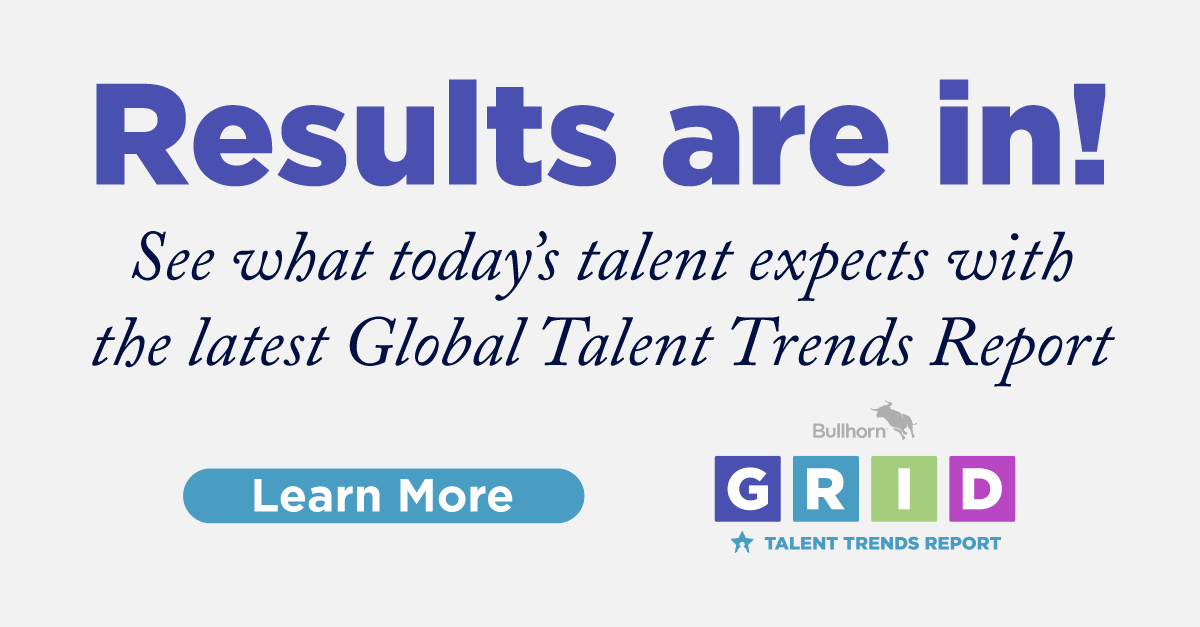Profitability and Margin
What is it?
Gross margin and Gross profit are two related metrics that are critical for understanding your business. Gross profit (GP) is the number of dollars of profit (dollars billed minus expenses and dollars paid) your business earns, while gross margin (GM) is the percentage of your total billable revenue that constitutes profits (dollars of profit divided by total revenue dollars).
What does it answer?
The most fundamental question answered by GP and GM is simple: how much money is my business actually making? However, financial data becomes a much more powerful tool when it lives in the same system as your ATS and CRM data and can be calculated at the level of each individual contract or placement.
When financial data is that granular, you can roll it up to easily answer a new set of important questions: How profitable is each line of my business? How does my margin differ by candidate source? What is my average profit per interview for a given team or segment? When you truly understand the successes (and failures) of each segment and activity of your business, you can then prioritise strategies and set goals to meaningfully improve growth and profitability.
How do you measure it?
Run a standard gross margin report for visibility into your business’ overall financial performance. Use ad-hoc reporting to segment your GM data to evaluate the profitability of each of your activities, prioritise resources, and proactively manage changing business conditions.
How can you use it?
If you’re in..
Leadership: Understand profit distribution within the business and guide strategic decision making. Which clients or segments deserve more attention? Which activities or recruiting strategies result in the best margins?
Recruiting: Decide which recruiting activities to focus on to maximise profits; margin also often factors into commissions.
Sales: Learn which clients have the largest impact on your bottom line with more accuracy than the job and placement volumes or total revenue alone.
Finance: Dive into tracking and understanding profits by looking at true GM by placement, allowing for stronger financial analysis and more opportunities for finance to have an impact on strategy.
Consider combining with Recruiter and Sales activity metrics to draw conclusions about your most profitable activities. Perhaps your recruiter who brings in the most profit turns out to also schedule the most interviews with candidates and make the most calls. Alternatively, you could have a team who has done a huge volume of placements but the report shows that gross margin is lower than expected.
Timesheet Actuals
What is it?
The number of hours your workers have clocked for their active placements.
What does it answer?
Analysing timesheet actuals will help your business better understand overall candidate hours worked, such as how many hours did a candidate log last week or how many total hours were worked last month across all current placements?
Looking into timesheet actuals can also uncover how many overtime hours are being clocked, which could inform additional decisions to hire more candidates or review the shifts.
How do you measure it?
Use ad-hoc reporting to show timesheet details for your candidates currently on assignment. Organise the report by time (week, month, quarter) or by type of hours (regular, overtime, holiday).
How can you use it?
If you’re in..
Recruiters: Answer questions from contractors about their timesheets. Putting this data at their fingertips in the same system as their applicant tracking system (ATS) workflow radically streamlines the availability of this data.
Leadership: Estimate weekly revenue using timesheet data and track changes over time.
Consider combining with profitability and margin metrics to better inform financial and efficiency goals for the team and to more accurately report on the financial progress of the business.
Fill Rate
What is it?
The percentage of total job orders that an agency has successfully filled.
What does it answer?
Fill rate is another efficiency measure that helps you understand if your agency is making the most out of its present opportunities. Because total placements are so important to your agency’s overall revenue, improving your fill rate is crucial to remaining profitable.
Improving fill rate is often an easier fix than increasing the total number of job orders overall so that the team is not spending time picking up more job orders they might be unable to fill.
How do you measure it?
Job orders filled divided by job orders received. Fill rate can easily be tracked on the Success Rates dashboard card, alongside hit rate (# of placements / # of client submissions). Fill rate can also be tracked on the Contact Fill Statistics dashboard card, providing visibility into overall fill rate percentages (along with submissions per interview and interviews per placement) for all the jobs associated with a given contact.
How can you use it?
If you’re in..
Leadership team: Make decisions on how to be more efficient and determine where to spend more or less time.
Sales: Pitch this data to prospective clients as a measure of how efficient or successful the team is.
Recruiting: Evaluate the placement success rate of your recruiters and teams, and help track new-hire ramp-up. You can also use Contact Fill Statistics to understand which people in your database are associated with high or low fill rates, providing valuable insight about what works and what doesn’t, and to help you prioritise.
Consider combining with time to fill and job coverage to more accurately track improvements to your recruiting efficiency. Create an informal health score on your performance metrics/recruiting process and fix holes in your screening. You can also look at hit rate alongside fill rate to evaluate how effectively your recruiters fill the jobs for which they submit a candidate.
Account Engagement
What is it?
The percent of account contacts at a given client or prospective customer you have contacted over time.
What does it answer?
Account engagement is a key metric to understand the quality of your customer relationships and where to focus your time and resources. How has your level of engagement with this client changed over time? Which accounts have gone dark? Where should you focus my efforts in order to maintain positive relationships?
How do you measure it?
Use the Account Engagement Dashboard Card, part of our Pulse suite of email-tracking-driven relationship-insights technology. This card displays the ratio of client contacts with which you’ve exchanged emails to total client contacts graphed per month or per year.
How can you use it?
If you’re in..
Sales: Evaluate which of your clients are engaged with you and which might be needing some additional communication.
Anyone: Quickly learn about your business’ contact history with a particular company in the event that you are unfamiliar with a given account.
Consider combining with financial data like Invoice Aging and other Pulse relationship insights cards like Email Conversation Activity, Most Responsive Contacts, and Top Engaged Coworkers work well with Account Engagement, and together they provide a comprehensive view into the health of your client relationships.
Redeployment Rate
What is it?
The percentage of workers coming off assignment who are then redeployed by your agency to another new assignment.
What does it answer?
How effectively is your business retaining your candidate pool over time? Redeploying candidates is a great way for your agency to maintain relationships with candidates and maintain the stream of revenue from that particular placement.
How do you measure it?
Look at the total number of workers coming off assignment each month, and divide the number who are redeployed by the total. You can also look at the average time it takes to redeploy a worker to further optimise retention.
How can you use it?
If you’re in…
Leadership: Evaluate redeployment rates over time and develop strategies to improve your candidate retention.
Recruiters: Look at the redeployment rates for your candidates to evaluate their performance over time.
Consider combining with M/GP in the context of redeployment can help you evaluate which of your redeployment strategies result in the largest profits for your agency.
Time to Submit First Candidate
What is it?
The time between a new job order being received and the submission of the first candidate to the client for consideration.
What does it answer?
In recruiting, time is everything. The faster you submit top candidates to a new job order, the better the chances are for a placement. Analysing time to submit can also help answer:
- How efficiently is your team able to identify, contact, onboard, and submit candidates to clients for a new job opening?
- Which segments of your business have the most and least friction in the submission workflow?
How do you measure it?
The Response Times dashboard card provides data on time to first Internal Submission, time to first Client Submission, and time to fill. This card can be filtered down to view only the data for a given time frame, recruiter, department, and more. You can also create ad-hoc reports in Canvas for more specific cuts of data.
How can you use it?
If you’re in..
Leadership: Evaluate which business segments or teams have the easiest time finding and submitting qualified candidates.
Recruiting: Track team efficiency, evaluate new-hire ramp-up, and identify recruiters who need improvement.
Operations: Track improvements to processes that drive document management and candidate communication/points of contact as onboarding processes will often affect time to submit.
Consider combining with time to fill and fill rate. Combining time to submit with other recruiting velocity and success-rate KPIs provides a more complete view into how efficiently and successfully your team navigates each stage of the recruiting process.
Invoice Aging
What is it?
The length of time invoices have been in your system without having been paid.
What does it answer?
It lets you know who you have to follow up with, where you need to take action and determine which clients are reliable and valuable. By aggregating across your customers, it also allows you to evaluate the overall efficiency of collections within your business.
How do you measure it?
In Bullhorn Canvas, pull the pre-built report for invoice aging, or create an ad-hoc report by pulling accounts receivable transaction by client and invoice paid status.
How can you use it?
If you’re in..
Leadership: Understand the health of your business and if you are going in the right direction.
Sales/Recruiting: Reduce invoice aging across your business.
Account managers: Empower yourself with relevant account information without making them rely on your billing team.
Billing team: Provide the visibility you need into client invoice aging history in a centralised system.
Consider combining with Pulse relationship-insights like Account Engagement to help understand your agency’s history and relationship with a given account.
Pipeline Velocity
What is it?
Pipeline velocity measures the average time it takes for a sales opportunity to move from one stage to another – for example, from Prospecting or Qualifying to Closed-Won. An important piece of this is also what percentage of opportunities in the first status ever reach the second.
What does it answer?
Pipeline Velocity answers questions about how efficient your sales processes are, either individually or in aggregate:
- How long does it take to close a new client after the first contact?
- How long does it take to negotiate contracts?
- When opportunities are lost, what stages of the sales cycle are most delayed?
- Which of your recruiters, teams, or industries are most efficient at closing new client deals?
How do you measure it?
Use the Pipeline Velocity dashboard card to easily view this KPI for your whole business, or specify department, recruiter, client, date range, industry, and more.
How can you use it?
If you’re in..
Sales – Evaluate sales efficiency similarly to how time to submit is used to look at recruiting efficiency.
Legal – Analyse the efficiency of your contracting process.
Consider combining with time to fill or win rate. These metrics can provide actionable insights into the success of the sales or recruiting teams and help the entire business increase visibility into where to focus attention or resources.
Job Coverage
What is it?
Job coverage KPIs and analytics allow you to look at the relative burden of each recruiter regarding the number of jobs they are working at any given time. Additionally, job coverage reporting helps quickly identify jobs for which important actions (interviews, internal submissions, and client submissions) have not yet been taken.
What does it answer?
Job coverage provides insight into a few key areas of your business, including:
- How many jobs does each recruiter cover? Who is covering too many or too few?
- Which jobs are not showing any interview or submission activity?
- Which recruiters, jobs, teams, or business lines tend to provide or receive the best coverage? The worst?
How do you measure it?
Use our Jobs Without Coverage dashboard card in the ATS to quickly view jobs added in a specified time range that are missing important activities. Use Canvas or the Job list view to pull data about the number of jobs each recruiter is assigned.
How can you use it?
If you’re in..
Leadership: Stay on top of potential inefficiencies resulting from poor or imbalanced job coverage.
Recruiting: Identify and prioritise jobs that require action.
Consider combining with redeployment rate. Combining these two metrics helps the recruiting team understand where to devote resources or where there is enough existing coverage to ensure all candidates are placed or redeployed in a timely manner.
Win Rate
What is it?
Win rate is a calculation of total opportunities won based on the total number of opportunities created.
What does it answer?
Analysing win rate can help uncover valuable insights into areas of success or those that could be improved. Where in the sales process are deals falling through? How are key competitors affecting win rate? Win rate can inform key decisions on what is or isn’t working within the sales process, the product/solutions being sold, or the competitive landscape in the industry.
How do you measure it?
Add up the number of opportunities won and divide by the total number of opportunities created.
How can you use it?
If you’re in..
Leadership: Understand the overall success of the team and track changes over time based on increased competition or changes in the industry.
Sales: Evaluate where the successes and failures of the team are and better understand where to focus efforts to maintain or improve the rate.
Consider combining with fill rate or any other sales or recruiter velocity KPI. Joining win rate with time to fill will provide a clear picture of what is working within the business and where the process needs to improve in order to grow revenue.


 Bullhorn’s marketplace of 100+ pre-integrated technology partners gives recruitment agencies the tools they need to build a unique, future-proof solution.
Bullhorn’s marketplace of 100+ pre-integrated technology partners gives recruitment agencies the tools they need to build a unique, future-proof solution.
